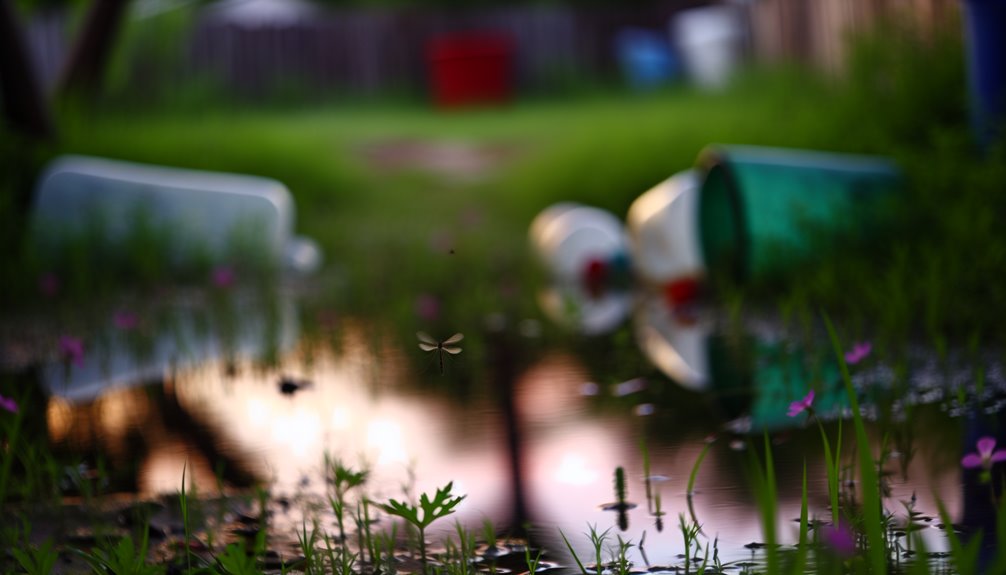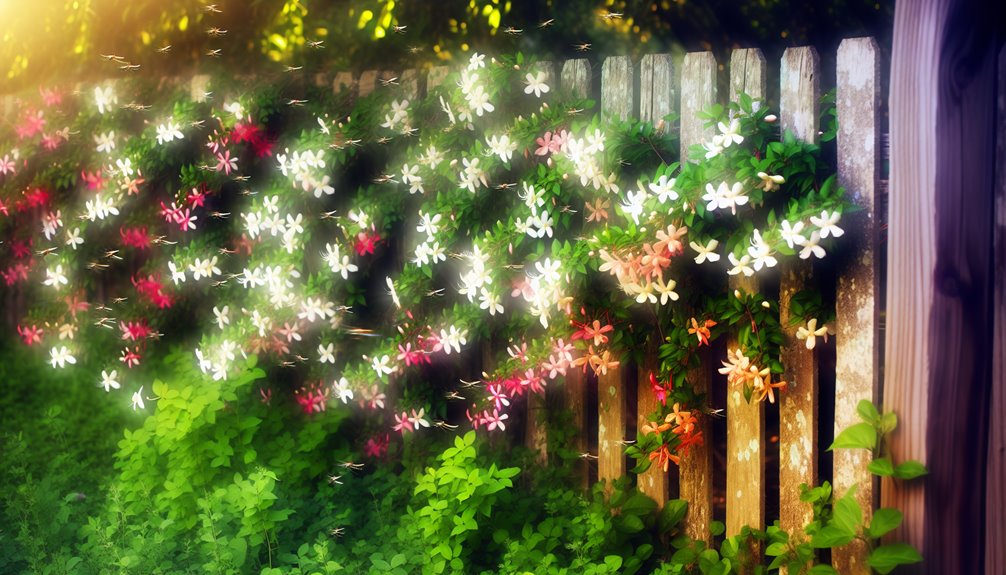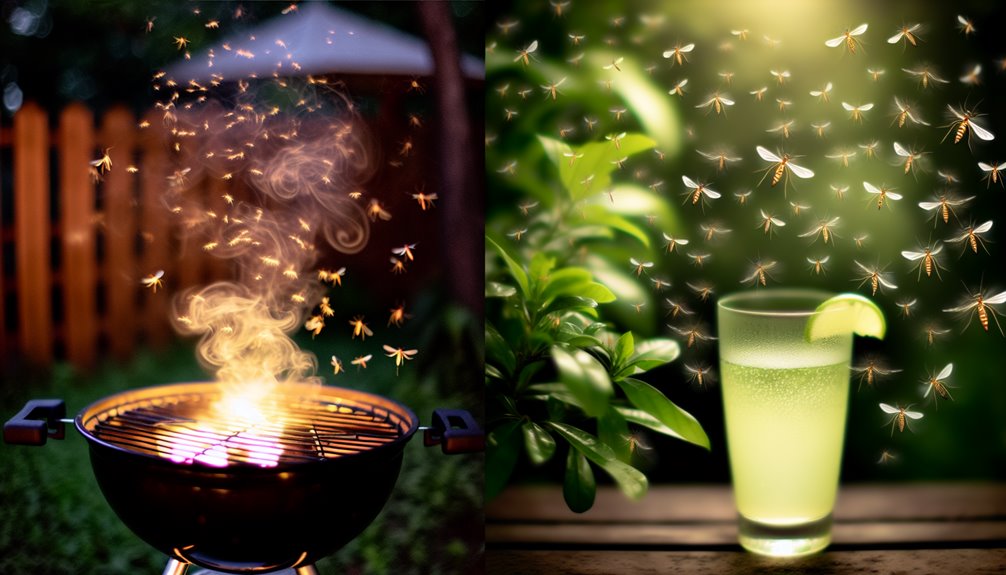You might not realize that the seemingly innocuous elements in your yard can create a perfect storm for attracting mosquitoes. From standing water to the choice of plants, various factors play a role in drawing these pests. Each element contributes to a complex ecosystem that thrives in South Mississippi. Understanding these factors can help you take effective measures against mosquito populations. What if you could transform your yard into a less inviting space for them?
Standing Water

When it rains or when irrigation is excessive, standing water can quickly become a breeding ground for mosquitoes in your yard.
Water stagnation, even in small amounts, creates an ideal environment for female mosquitoes to lay their eggs. These pests thrive in pools of water that remain undisturbed, as they require just a few inches of stagnant water for successful reproduction.
By understanding the science behind mosquito breeding, you can take proactive steps to minimize their presence. Regularly inspect your yard for any containers, puddles, or clogged drains that may accumulate water.
Eliminating these sources not only reduces mosquito populations but also contributes to a healthier ecosystem, ultimately serving your community by preventing the spread of mosquito-borne diseases.
Dense Vegetation
Although dense vegetation may provide shade and aesthetic appeal to your yard, it also creates a favorable habitat for mosquitoes. The presence of dense foliage allows these pests to hide from predators and seek refuge from harsh weather conditions.
This environment supports moisture retention, further enhancing mosquito habitats. When vegetation is thick, it traps humidity, creating microclimates that are perfect for breeding. Additionally, the organic matter in dense areas often serves as a nutrient source for mosquito larvae.
To reduce mosquito populations, consider thinning out overgrown areas, properly maintaining your landscaping, and ensuring airflow. By managing dense vegetation, you can create a less inviting environment for mosquitoes, ultimately contributing to a healthier outdoor space for you and your family.
Certain Flowering Plants

Certain flowering plants can greatly influence mosquito attraction in your yard. Species with fragrant blooms, such as lavender and marigold, release specific scents that entice these pests.
Mosquitoes are particularly drawn to plants that provide ample nectar sources, as they rely on this sugary substance for energy. For instance, bee balm and butterfly bush not only attract beneficial pollinators but also serve as potential mosquito magnets due to their nectar-rich offerings.
It’s important to assess the balance between creating an inviting environment for pollinators and minimizing mosquito populations. By selectively choosing flowering plants, you can enhance your yard’s aesthetics while managing the mosquito presence more effectively.
Understanding these dynamics is essential for creating a harmonious outdoor space for both wildlife and yourself.
Body Heat and Sweat
Body heat and sweat play significant roles in attracting mosquitoes to your yard. When you’re active or it’s hot outside, your skin temperature rises, creating an inviting environment for these pests.
Mosquitoes are highly sensitive to heat, detecting the warmth radiating from your body. Additionally, the sweat you produce contains various compounds, which can contribute to body odor. Certain chemicals in sweat, like lactic acid and ammonia, are particularly appealing to mosquitoes.
This combination of elevated skin temperature and distinctive body odor signals to mosquitoes that a potential meal is nearby. By understanding these factors, you can take steps to minimize your attractiveness to mosquitoes and create a more enjoyable outdoor space for yourself and others.
Carbon Dioxide Emission

Carbon dioxide (CO2) emissions are a key factor in attracting mosquitoes to your yard. When you breathe, your respiratory rate increases, releasing CO2 into the air.
Mosquitoes are highly sensitive to this gas, using it as a primary cue to locate potential hosts. If you’re active outdoors, your carbon footprint grows, intensifying CO2 emissions and, consequently, your attractiveness to these pests.
It’s vital to be aware of how your activities contribute to this phenomenon. By reducing unnecessary movement or using carbon-efficient practices, you can lower your CO2 output.
This not only minimizes your carbon footprint but also helps create a less inviting environment for mosquitoes, allowing you to enjoy your yard more peacefully while serving both your needs and the ecosystem.
Dark Clothing
While you mightn’t consider your wardrobe a factor in mosquito attraction, wearing dark clothing can greatly increase your visibility to these pests.
Mosquitoes are naturally drawn to dark clothing colors, which contrast sharply against lighter backgrounds. This heightened visibility makes you an easier target as they rely on sight to locate hosts.
Studies show that mosquitoes are particularly attracted to people dressed in black or navy, which absorb heat and emit more body heat—another attractant.
To enhance your mosquito bite prevention strategies, opt for lighter shades, especially during peak activity times. Additionally, consider using insect-repellent fabrics.
Pet Food and Waste
Pet food and waste can greatly attract mosquitoes to your yard, increasing the risk of bites. Unattended pet bowls left outdoors create a buffet of nutrients, drawing mosquitoes looking for sustenance.
Stagnant water in these bowls can also serve as breeding grounds for these pests. Furthermore, pet waste is a magnet due to its organic material, providing an ideal environment for mosquito larvae.
Proper waste disposal is essential; promptly cleaning up after your pets minimizes potential breeding sites. Regularly empty and clean pet bowls, and make sure any waste is disposed of in sealed bags.
Outdoor Lighting
Outdoor lighting plays an essential role in attracting mosquitoes to your yard, with certain types of lights being more appealing than others.
Traditional incandescent bulbs emit a broad spectrum of light, which entices these pests. In contrast, LED lights provide a more targeted wavelength, often reducing mosquito attraction.
Additionally, using motion sensors can minimize light exposure during inactive hours, deterring mosquitoes from lingering. By strategically placing LED lights with motion sensors, you can create a less inviting environment for mosquitoes while still enjoying your outdoor space.
Choose warmer tones in your lighting design, as bright white or blue lights tend to attract more insects.
Climate and Weather Conditions
The interplay between climate and weather conditions greatly influences mosquito populations in your yard. High humidity levels, typical of South Mississippi, create an ideal breeding environment for these pests.
Mosquitoes thrive in moist conditions, as stagnant water accumulates in your yard during rainy periods, allowing them to reproduce rapidly. Seasonal patterns also play an essential role; warmer temperatures in spring and summer extend the active mosquito season, while cooler months lead to a decline in their numbers.
Understanding these dynamics can help you mitigate mosquito presence effectively. By managing humidity around your home and recognizing seasonal cycles, you can take proactive measures to create a less inviting environment for these insects, ultimately serving your community by reducing their prevalence.
Conclusion
As the proud owner of Mosquito Eliminators of South MS, I truly understand the challenges that mosquitoes can bring to our beautiful yards in South Mississippi. It’s heartening to know that by making a few simple changes, we can significantly enhance our outdoor experiences and keep those pesky invaders at bay. If you’re ready to take control of your yard and enjoy your space without the buzz, I invite you to visit us at mosquitoeliminatorsms.com or give us a call at (601) 336-2277. Together, we can create a peaceful outdoor haven for you and your loved ones. I look forward to helping you reclaim your yard!

